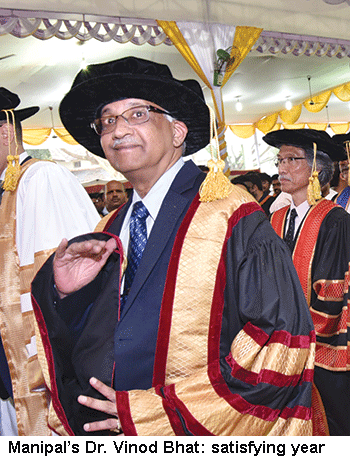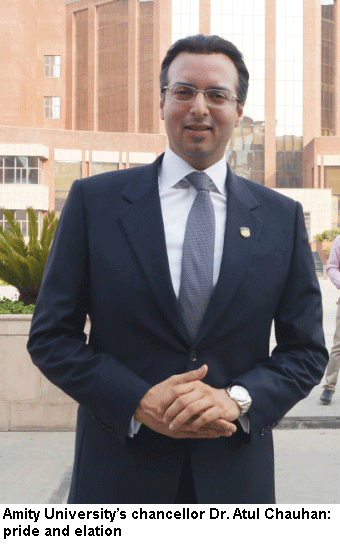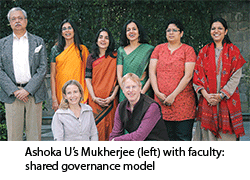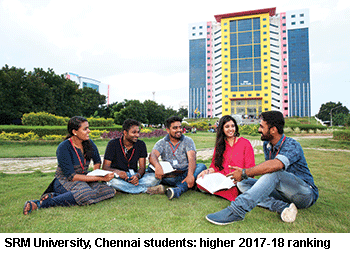A sample database of 4,465 knowledgeable respondents — 2,133 higher education faculty, 1,368 final year students of 164 universities and 964 industry representatives — rated and ranked India’s top 100 private universities 2017-18 on ten parameters of education excellence – Dilip Thakore
Top-ranked for the second consecutive year in the EducationWorld India Private University Rankings (EWIPUR) 2017-18, this year the Manipal (Karnataka)-based Manipal University (MU) has to share top billing with the fast-track Amity University, Noida (Delhi NCR/Uttar Pradesh). A sample database of 4,465 knowledgeable respondents — including 2,133 higher eduation faculty, 1,368 final year students of 164 universities, and 964 industry representatives in 25 cities — rated India’s Top 100 private universities (out of a total of 260) on ten parameters of education excellence, viz, competence of faculty, faculty welfare and development, research and innovation, curriculum and pedagogy, industry interface, infrastructure, internationalism, placement record, leadership and diversity of study programmes.
Top-ranked on the parameters of internationalism, infrastructure and diversity of study programmes, the fast-growing Amity University, which advertises its achievements heavily on national English news and sports channels and was ranked #3 last year, has vaulted to #1 position, which it shares with MU this year.
As a result, there’s been a re-arrangement of the seating order at the Top 10 table of private universities in 2017-18. The Birla Institute of Technology & Science (BITS)-Pilani (Rajasthan) ranked second last year is #3 this year followed by VIT University at #4 (#5 in 2016-17) and the newbie Ashoka University (estb. 2014), which has risen spectacularly in the public esteem, is ranked #5 (9).
 “I am elated that Manipal is ranked India’s #1 private university by EducationWorld in its 2017 league tables for the second year in succession. This has been a very satisfying year for Manipal University in terms of performance and recognition. In the Central government’s NIRF 2017 league table released in April, MU is ranked #1 in Karnataka above all universities, including public universities and #18 in India. Similarly, we have also been well-ranked in the BRICS and Asia rankings of the London-based QS and Times Higher Education, and for the first time we have been featured in Times Higher Education World specialty lists for medicine and pharmacy. Although I am pleased with our overall ranking I would have been happier if we were top-ranked for academics, research, faculty and reputation. But we are working on these issues and I am certain we will soon get there,” says Dr. Vinod Bhat, FRCS and alumnus of Glasgow University who signed up with MU in 1988 and was appointed vice chancellor in 2015. Currently, Manipal University’s 20 schools offer 381 study programmes to 33,563 students mentored by 2,645 faculty.
“I am elated that Manipal is ranked India’s #1 private university by EducationWorld in its 2017 league tables for the second year in succession. This has been a very satisfying year for Manipal University in terms of performance and recognition. In the Central government’s NIRF 2017 league table released in April, MU is ranked #1 in Karnataka above all universities, including public universities and #18 in India. Similarly, we have also been well-ranked in the BRICS and Asia rankings of the London-based QS and Times Higher Education, and for the first time we have been featured in Times Higher Education World specialty lists for medicine and pharmacy. Although I am pleased with our overall ranking I would have been happier if we were top-ranked for academics, research, faculty and reputation. But we are working on these issues and I am certain we will soon get there,” says Dr. Vinod Bhat, FRCS and alumnus of Glasgow University who signed up with MU in 1988 and was appointed vice chancellor in 2015. Currently, Manipal University’s 20 schools offer 381 study programmes to 33,563 students mentored by 2,645 faculty.
 Dr. Atul Chauhan, chancellor of Amity University, Noida (AU, estb. 2003), is equally elated that this fast-track institution which has since engendered the promotion of nine clones in seven states across India and eight abroad, is jointly ranked India’s #1 private university this year. “It’s a matter of great pride for us in AU that we are ranked India’s #1 private university in the EducationWorld annual rankings of the country’s Top 100 private universities. It’s is testimony that our pursuit of academic excellence across a broad range of parameters is bearing fruit. It’s a good year for us because we are also ranked India’s #1 not-for-profit private university in the Union HRD ministry’s NIRF 2017. Moreover for the first time, AU is also included in the league tables of the London-based higher education research agency QS this year,” says Chauhan.
Dr. Atul Chauhan, chancellor of Amity University, Noida (AU, estb. 2003), is equally elated that this fast-track institution which has since engendered the promotion of nine clones in seven states across India and eight abroad, is jointly ranked India’s #1 private university this year. “It’s a matter of great pride for us in AU that we are ranked India’s #1 private university in the EducationWorld annual rankings of the country’s Top 100 private universities. It’s is testimony that our pursuit of academic excellence across a broad range of parameters is bearing fruit. It’s a good year for us because we are also ranked India’s #1 not-for-profit private university in the Union HRD ministry’s NIRF 2017. Moreover for the first time, AU is also included in the league tables of the London-based higher education research agency QS this year,” says Chauhan.
Chauhan is especially enthused that Amity University is top ranked under the parameters of internationalism, range and diversity of programmes offered and infrastructure. “Right from inception, our wide range of study programmes have been meticulously designed to provide flexibility and exposure to a large pool of cross-cultural and inter-disciplinary knowledge, cutting across national boundaries. Amity has its own universities in Dubai, USA and international campuses in London, Singapore, Mauritius, South Africa, Romania and China. Our objective is to make our students industry-ready and globally employable before they step outside our portals. I’m pleased that your sample respondents have acknowledged our efforts in this direction,” he adds. Currently Amity University, Uttar Pradesh (Noida and Lucknow campuses) has an enrolment of 32,731 students and 2,039 faculty.
As a consequence of the high-profile Amity rising substantially in the public esteem, the low-profile Birla Institute of Technology and Science (BITS), Pilani has yielded one rank, although it’s still ranked the country’s premier engineering university/institute (see p.60), closely followed by the well-reputed Vellore (Tamil Nadu)-based VIT University which despite its modest #14 ranking in the Union HRD ministry’s NIRF Rankings 2017, is positioned #4 among private universities and #2 among engineering universities/institutions by the knowledgeable 4,465 EducationWorld sample respondents, with a #1 rating under the critically important parameter of research and innovation. Unfortunately, our efforts by phone, fax and e-mail to enthuse Dr. G. Vishwanathan — a politician-turned-edupreneur who established the Vellore Institute of Technology in 1984 — proved unsuccessful.
 But as last year, the stellar performer in the EWIPUR 2017-18 is Sonipat (Haryana-Delhi NCR)-based wholly residential Ashoka University (estb. 2014) — India’s first crowd-funded (90 major donors) not-for-profit liberal arts university. Within two years since it admitted its first batch of students, Ashoka was voted into the Top 10 in 2016, and into the Top 5 national this year. Also ranked the #1 private university in the education-friendly state of Haryana, more significantly, Ashoka is top-ranked nationally on the parameters of curriculum design and pedagogy and leadership quality, and is among the Top 3 under other parameters (faculty competence and internationalism). With 2,646 admission applicants, of whom 336 were admitted last year, Ashoka University has clearly emerged as the acceptable (annual tuition-cum residential fees: Rs.7.85 lakh) Indian alternative to America’s ruinously expensive Ivy League liberal arts universities.
But as last year, the stellar performer in the EWIPUR 2017-18 is Sonipat (Haryana-Delhi NCR)-based wholly residential Ashoka University (estb. 2014) — India’s first crowd-funded (90 major donors) not-for-profit liberal arts university. Within two years since it admitted its first batch of students, Ashoka was voted into the Top 10 in 2016, and into the Top 5 national this year. Also ranked the #1 private university in the education-friendly state of Haryana, more significantly, Ashoka is top-ranked nationally on the parameters of curriculum design and pedagogy and leadership quality, and is among the Top 3 under other parameters (faculty competence and internationalism). With 2,646 admission applicants, of whom 336 were admitted last year, Ashoka University has clearly emerged as the acceptable (annual tuition-cum residential fees: Rs.7.85 lakh) Indian alternative to America’s ruinously expensive Ivy League liberal arts universities.
“Ashoka University is just three years old. Therefore, we are greatly encouraged that your knowledgeable respondents have ranked us among India’s Top 5 private universities. I believe this is because we recruit subject experts from around the world and are building a model university which will inspire many other institutions to recognise the value of liberal arts education. We are especially delighted to be top-ranked on the parameters of leadership quality and curriculum and pedagogy design. The high rankings on these parameters are because our academic and administrative leaders are deeply committed to the mission and vision of Ashoka University, and have designed a shared governance model,” says Dr. Rudrangshu Mukherjee, a history alumnus of Presidency College, Kolkata, JNU, Delhi and Oxford University, and former editor of The Telegraph, Kolkata (1993-2014) who was appointed the first vice chancellor of Ashoka U in 2014.
 As a consequence of the reshuffle of the Top 5 seating order, there has been a minor rearrangement of the Top 10 table. IIIT-Hyderabad (classified as a specialised university and therefore rated poorly under the newly-introduced parameter of ‘diversity of study programmes’) has yielded rank as has Thapar University, Patiala. However, the Amrita Vishwa Vidyapeetham, Coimbatore — India’s #1 private university according to the Union HRD ministry’s NIRF 2017 — has retained its #8 ranking of last year, while the Chennai-based SRM University has improved its ranking to #8 (from #10 last year). Likewise, SASTRA University, Thanjavur (Tamil Nadu) has risen in the public estimation and is ranked #10 (13).
As a consequence of the reshuffle of the Top 5 seating order, there has been a minor rearrangement of the Top 10 table. IIIT-Hyderabad (classified as a specialised university and therefore rated poorly under the newly-introduced parameter of ‘diversity of study programmes’) has yielded rank as has Thapar University, Patiala. However, the Amrita Vishwa Vidyapeetham, Coimbatore — India’s #1 private university according to the Union HRD ministry’s NIRF 2017 — has retained its #8 ranking of last year, while the Chennai-based SRM University has improved its ranking to #8 (from #10 last year). Likewise, SASTRA University, Thanjavur (Tamil Nadu) has risen in the public estimation and is ranked #10 (13).
Further down the EWIPUR 2017-18 Top 100 league table, some low-profile institutions have risen in the opinion of the informed public. Among the gainers: Shiv Nadar University, Delhi NCR/Uttar Pradesh at #11 has moved up a notch (#12 in 2016) as have KIIT University at #15 (16), Satyabhama University ranked #17 (#28) together with Christ University, Bangalore (#20). On the other hand, the low-profile Dhirubhai Ambani Institute of Information Communication & Technology (DAIICT), Gandhinagar (Gujarat) ranked #12 (#7) and Azim Premji University, Bengaluru ranked #20 (#15) — promoted by big names in Indian industry — have yielded ground.
However, varsities which don’t make the Top 10-20 tables need not feel discouraged. Because several institutions ranked way down in the national league table are ranked at the very top in their host states. For instance, GITAM (Gandhi Institute of Technology and Management) University in the port city of Vishakapatnam, ranked #29 nationally, is top ranked in the southern state of Andhra Pradesh (pop. 52 million), and Amity University, Raipur ranked #94 in the national league table is ranked #1 in Chhattisgarh (pop. 28 million).
Indeed, with the majority of India’s 29 states, if not the seven Union territories being larger in terms of territory and population than most European countries, it’s arguable that state rankings, are more important and meaningful than national rankings because only a small minority of students are likely to travel beyond state borders for school or higher education. In the circumstances, state rankings assume great significance.
For instance, although the Pune-based multi-disciplinary Symbiosis International University (estb. 2002) has yielded two ranks this year in the national league table, it has nevertheless retained its #1 ranking in Maharashtra (pop.115 million), India’s most industrialised state accounting for one-fifth of national industrial output. Similarly DAIICT, Gandhinagar, which has also yielded ground this year, retains its #1 ranking in Gujarat (pop. 63 million), India’s fastest industrialising state.
Likewise, the newly-promoted Ashoka and O.P. Jindal, Manav Rachna, BML Munjal, Northcap (formerly ITM) and Apeejay universities — all private varsities in Delhi NCR — have transformed the predominantly rural state of Haryana into a hub of higher education excellence. Similarly the Shoolini University of Biotechnology and Management Sciences, Chitkara and Jaypee University of Information Technology have changed the education profile of the scenic state of Himachal Pradesh (pop. 7 million) which also hosts several excellent private schools. Therefore parents and school-leaving students searching for qualitatively superior higher education options are advised to also carefully check out the EWIPUR 2017-18 state league tables (see pages 52-55).
Although comfortably-tenured, low-productivity left-liberal academics routinely demonise India’s 260 private universities and privately-promoted institutions of education in general for “commercialisation of education” while doing little to stem the spreading rot in the country’s 411 over-subsidised Central and state government universities, thanks to the commitment and diligence of a growing community of bona fide educationists and philanthropists, the number of private institutions of higher education which already tutor 65 percent of the country’s 29 million youth in tertiary education, is growing steadily.
Admittedly, there is a substantial number of private institutions of higher education established by politicians, real estate moguls and assorted shady characters which short-change and gull parents and students across the country. However India’s Top 100 private universities, engineering institutes and B-schools featured in the annual EWIPUR offer parents and students who value quality education — and are ready to pay for it — an alternative to the great majority of government universities ruined by political and bureaucratic micro-management and interventions.
Parameters of excellence: India’s Top 10 private universities
To compile the EW India Private University Rankings 2017-18, C fore field researchers interviewed 2,133 faculty, 1,368 final year students and 964 industry managers countrywide, asking them to rate institutions on ten parameters, viz, competence of faculty, faculty welfare and development, research and innovation, curriculum and pedagogy, industry interface, placements record, infrastructure and facilities, internationalism, leadership/governance quality and range/diversity of programmes offered. Further, the informed interviewees were also asked to assign weightage to each parameter. The scores awarded by the respondents were totaled to rank India’s Top 10 universities under each parameter of higher education excellence.
The ‘research and innovation’ parameter was assigned highest weightage (300) indicating that respondents believe that the ability of faculty to engage in meaningful research and development including publication of papers in reputed international journals, is the most important criterion for assessing the educational capabilities of universities. Parameter rankings which highlight the prime strengths of highly ranked institutions are useful because they enable students to select institutions whose priorities dovetail with their own.
Also read: India’s best private Engineering Institutes 2018-19























